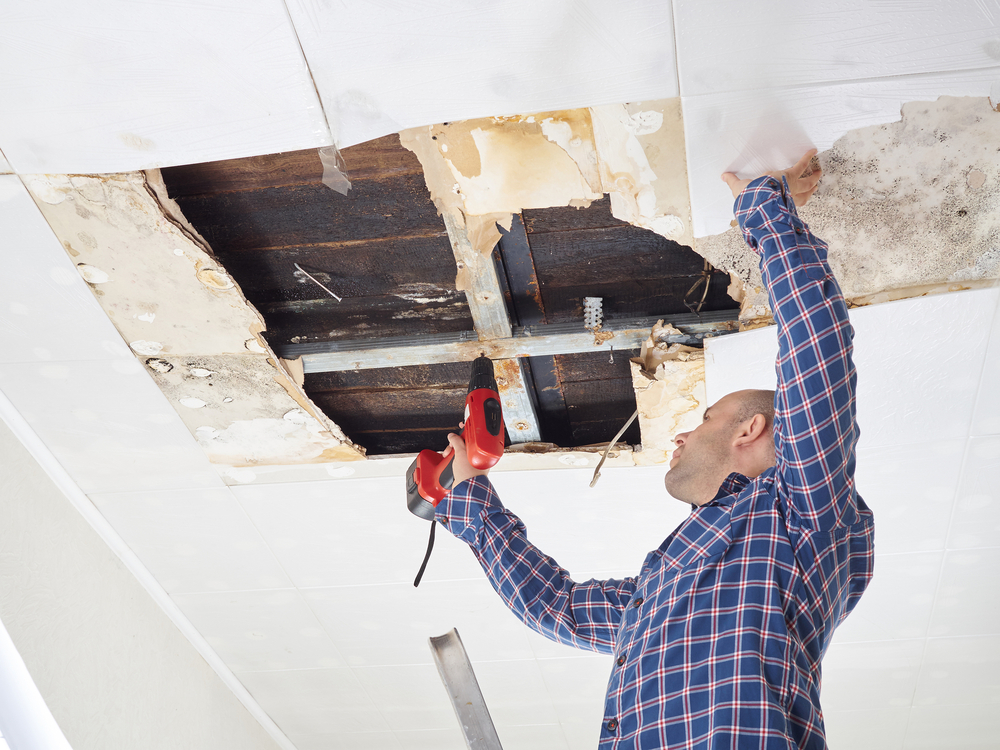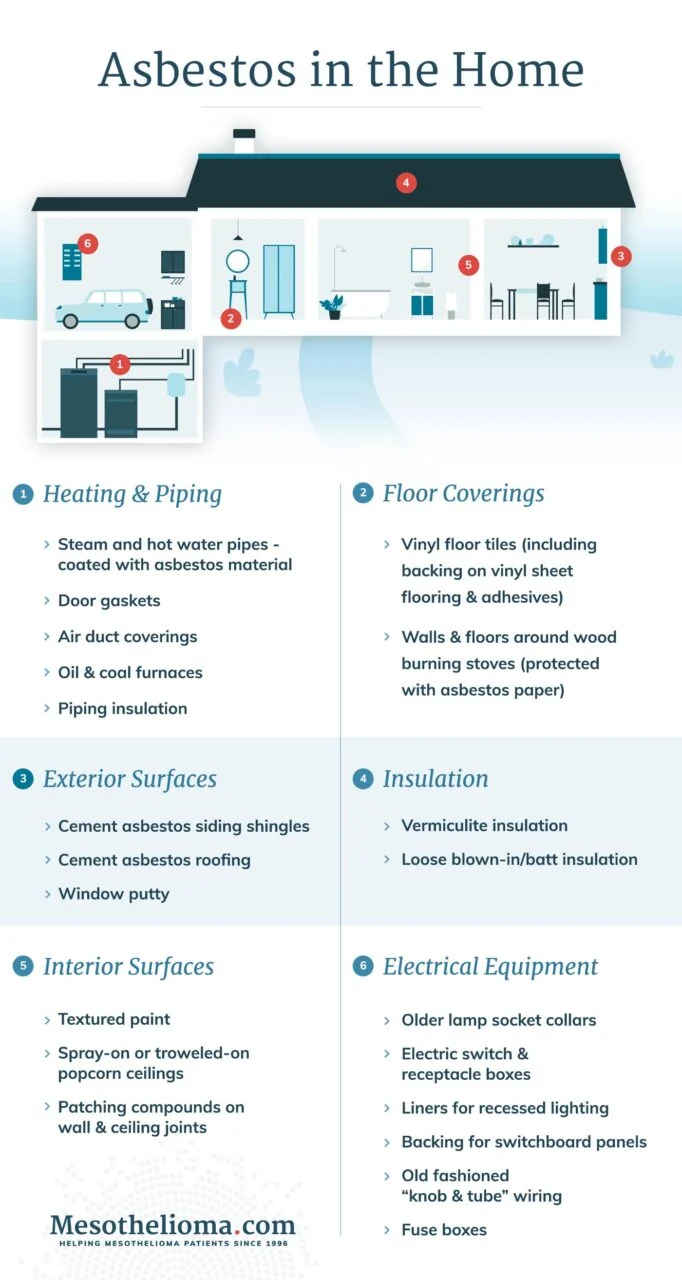Asbestos in your home – What you need to know.

When Was Asbestos Used in the Home?
Before the 1980s, asbestos was commonly used in thousands of consumer products and building materials. BUT It can still be used today!
According to the U.S. Environmental Protection Agency (EPA), more than 30 million tons of asbestos were used between 1900 and 1980. Some of these past uses are still in materials and products people may come into contact with today.
There is less asbestos risk in newer homes. Although asbestos is not fully banned in the United States, newer homes typically were not built with asbestos-containing materials. Homes built after 1980 are less likely to contain asbestos. However, stockpiles of asbestos-containing materials may have been used into the 1990s.
Common Asbestos-Containing Materials Found in the Home
- Asbestos rope/sheet
- Boiler insulation
- Ceiling tiles
- Cement roofing
- Cement sheets
- Duct/pipe insulation
- Furnaces
- Joint compound
- Millboard
- Rollboard
- Roof shingles
- Roofing felt
- Sheetrock
- Siding shingles
- Vermiculite attic insulation
- Vinyl floor tiles
- Vinyl sheet flooring
How to Identify Asbestos in the Home
It is not possible to identify asbestos-containing materials with the naked eye. However, there are signs of asbestos homeowners can look for. These clues may hint toward the presence of the mineral in certain products.
For example, the older a home is, the more likely asbestos materials were used during its construction. Homes built before 1980 should be assumed to contain the mineral somewhere. Newer homes are less likely to contain asbestos products though it is still very possible.
Vinyl floor tiles have a high likelihood of containing the mineral. However, these products came in a variety of shapes and sizes, and not all used asbestos in their production.
Asbestos exposure can occur anywhere in the house. Common sources of asbestos exposure in the home include:
- Roofs
- Attics
- Crawl spaces
- Floors
- Walls
- Ceilings
The only definitive way to determine whether a questionable product contains asbestos is to have a professional test for it. In the meantime, it’s best to limit damage and avoid handling materials suspected to contain asbestos until the tests are complete.
What to Do When Asbestos Is Found in Your Home
In general, asbestos materials are considered safe when they are in good condition and there are no signs of damage.
If the material is damaged or worn, a professional may suggest removing or encapsulating the product. Encapsulation involves covering the materials with a sealant to prevent airborne fibers.
At no point should a homeowner attempt to perform removal of asbestos on their own.
According to the Occupational Safety and Health Administration (OSHA), there is no safe level of asbestos exposure. Improper handling of the material could release fibers into the air, creating a health hazard.
How Federal Asbestos Regulations Protect Homeowners
Federal regulations have reduced the amount of asbestos used in construction and manufacturing. In 1973, the United States used more than 800,000 tons of asbestos, compared to only a few hundred tons today.
Although reducing asbestos use is good, without a complete ban, homeowners are still at risk. People are still coming into contact with items containing asbestos at home and/or on the job.
History of Asbestos Bans in the U.S.
Asbestos is not banned in the United States. Asbestos mining was banned in 2002 with the closing of the last U.S. asbestos mine. However, it is still legal to import and use the mineral in small amounts. Without a complete ban, many products still legally contain up to 1% of the mineral.
Partial Ban on Asbestos, 1989
This ban prohibits the manufacture, import, processing and distribution of some asbestos-containing products.
Items Included in the Ban:
- Corrugated paper
- Rollboard
- Commercial paper
- Specialty paper
- Flooring felt
- New uses of asbestos
Attempts at Asbestos Bans: Early 2000s
In the early and mid-2000s, lawmakers introduced two bills that would have enacted strict regulations and/or complete bans on asbestos:
- The Ban Asbestos in America Act (the Murray Bill)
- The Bruce Vento Ban Asbestos and Prevent Mesothelioma Act
Congress did not pass either piece of legislation.
The Bruce Vento Ban Asbestos and Prevent Mesothelioma Act was introduced on September 15, 2008. The goal of the bill was to strengthen the TSCA by banning more types of asbestos-containing products.
The bill did not pass Congress.
The Frank R. Lautenberg Chemical Safety for the 21st Century Act gives Congress the power to ban asbestos. In 2016, this act added asbestos to the list of top 10 chemicals for priority action. This bill was signed under President Obama.
However, the EPA has not banned asbestos under this law.
The Brazilian asbestos ban, enacted in 2017, has not stopped the transport and exportation of the mineral. From 2015 to 2018, Brazil was responsible for 96% of all asbestos imports into the United States.
According to the most recent data, all the asbestos imported into the country in 2019 came from Russia.
United States’ Asbestos Consumption Trends 2013-2019:
- 2013: 772 tons
- 2014: 406 tons
- 2015: 325 tons
- 2016: 747 tons
- 2017: 332 tons
- 2018: 750 tons
- 2019: 100 tons
Georgia EPD Regulations
Do I need an asbestos inspection?
Yes, for demolition projects. You also need an inspection for a renovation or abatement, unless all material is presumed to be asbestos-containing and is handled as such. You cannot presume the material does not contain asbestos.
What is friable asbestos-containing material (ACM)?
Any material containing more than one percent asbestos, as determined by polarized light microscopy, that when dry can be crumbled, pulverized, or reduced to powder by hand pressure (also see definition of RACM below).
Does EPD consider floor tile removal a regulated “friable” project?
EPD considers intact floor tile non-friable ACM; however, upon disturbance it becomes friable. EPD uses two criteria to determine whether a floor tile project is regulated or not:
- The condition of the floor tile
- The method(s) that will be used to remove the floor tile and mastic (if present)
A floor tile project that is removing tiles using “mechanical means,” such as long-handled scrapers (e.g., ice chippers, shovels, spud bars), powered mechanical chisels, or shot-blasters is considered a regulated friable project since these methods subject the floor tiles to breakage and, therefore, generate RACM.
Are New Properties Excluded from GA EPD Regulations?
No. It is still legal to manufacture products with ACM, therefore there is no exclusion date in Georgia’s regulations for properties of any age
Do you need an inspection?
Prior to renovation or ACM abatement (removal), yes, unless all of the material is
presumed to be asbestos containing and is handled as such.
You cannot presume the material to be non asbestos containing.
A thorough inspection must be performed by an accredited Asbestos Inspector and should include a report which identifies all ACMs in the facility that might be disturbed during the renovation or demolition
If asbestos is present and not removed prior to disturbance, the contractor and property owner carry equal responsibility.
At RestoPros of Northeast Georgia, we always require an asbestos test when we determine we may need to remove affected materials in a home after water damage has occurred. If you are dealing with a water mitigation who is not doing this, they are putting you and your health at risk.

Fr your safety and their employees safety, any repair contractor or water restoration company that you plan to hire should be adhering to the following regulations, regardless of the age of your home.
Please note that the State of Georgia Asbestos Program and the industry overall is subject to five regulations, and the most stringent regulation takes precedent in any given situation. The five regulatory references must include:
- GA Asbestos Removal & Encapsulation; 391-3-14;
- GA Solid Waste Rules – Asbestos; Chapter 391-3-4;
- AHERA 40 CFR Part 763 Subpart E;
- NESHAP 40 CFR Chapter 1 Subpart M 61.140; and
- OSHA 29 CFR 1926.1101.
The definition of Demolition is: The wrecking or removal of any load-supporting structural member of a facility, together with any related handling operations.
The definition of Renovation is: Altering a facility or one or more facility components in any way, including the stripping or removal of RACM from a facility component.
In an emergency, such as a water leak or sewer leak or structure damage, a restoration company is hired to remediate the emergency. This would include, but not be limited to, the immediate requirements of removing water, sewage, providing the structure with cover and security, adding air humidifiers to decrease moisture. The activities are limited to the immediate remediation of the emergency. That restoration contractor is not required to be an asbestos abatement firm. In an emergency, once the crisis is under control, all activities following are subject to asbestos abatement contractor requirements, regulations, protocols. The GA Asbestos Removal and Encapsulation Rules 391-3-14 and the GA Solid Waste Rules – Asbestos 391-3-4 would then apply.
Asbestos Inspection: There is not a line item for the requirement for asbestos inspection in the Georgia Asbestos Rules 391-3-14. However, GA EPD has adopted the federal NESHAP 40 CFR Chapter 1 subpart 61.140 which states that the owner or operator of a demolition or renovation activity, and prior to the commencement of the demolition or renovation, thoroughly inspect the affected facility or part of the facility where the demolition or renovation operation will occur for the presence of asbestos, including Category I and Category II non-friable ACM.
The Georgia Solid Waste Rule is really the rule that establishes the requirement for asbestos inspections in Georgia. It states that any solid waste over 1% asbestos content, must be properly packaged, labeled, transported, and disposed in a landfill that accepts asbestos. To comply with the rule, asbestos-containing material must be identified and properly handled. This means that any project, demolition or renovation, that will create solid waste in any quantity or type (friable or non-friable material) is subject to the Georgia Solid Waste Rule – Asbestos. An asbestos inspection is required.
The Georgia Project Notification for Asbestos Abatement, Encapsulation, and/or Renovation is required for any projects of 10SF/10LF of friable ACM, and on page 1 section 4, it has a question asking if asbestos is present. It also asks the name of the asbestos inspector and their credentials. This project notification is required for the abatement of the identified asbestos-containing material(s) and includes a fee and a waiting period of 10 days prior to the start of the abatement.
The Georgia Project Notification Form for Demolition is required for all demolitions in the State of Georgia, whether asbestos is identified and removed, or not found. It also asks if asbestos is present and the name and credentials of the inspector. There is a 10-day waiting period, prior to the start of the demolition, for this project notification as well.
